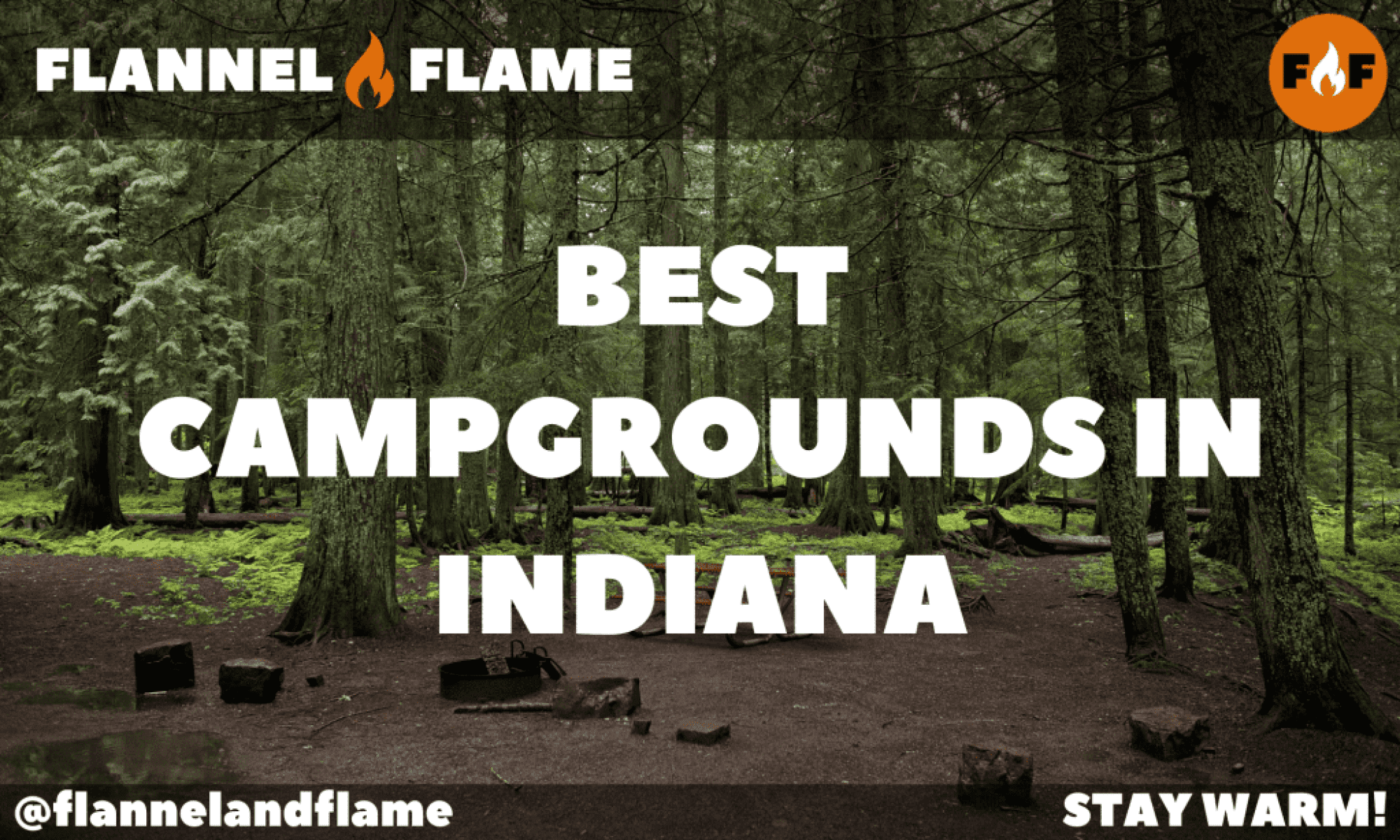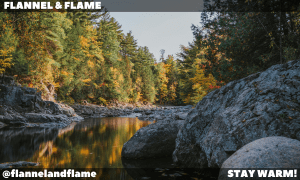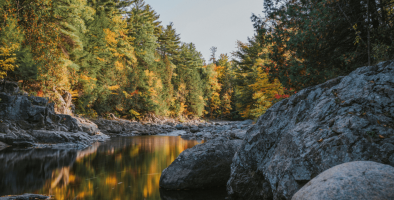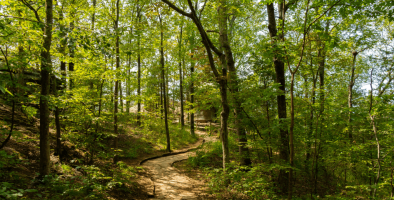Best Campgrounds in Indiana
Indiana’s diverse landscape offers campers a remarkable range of outdoor experiences, from the rolling hills of the south to the sandy dunes along Lake Michigan in the north. The Hoosier State surprises visitors with its hidden natural treasures—pristine lakes, old-growth forests, rugged canyons, and sprawling caves. Whether you’re seeking family-friendly amenities or secluded wilderness, Indiana’s campgrounds provide perfect basecamps for exploring landscapes carved by ancient glaciers and shaped by flowing water. From spring wildflowers to spectacular fall foliage, each season brings its own magic to these outdoor destinations across the state.
Brown County State Park
Number of Campsites: 401 (electric and non-electric)
Reservation Website: Reserve.IndianaStateParks.IN.gov
Address: 1810 State Road 46 East, Nashville, IN 47448
Known affectionately as the “Little Smokies,” Brown County State Park unfolds across nearly 16,000 acres of stunning forested hills and valleys in southern Indiana. As the state’s largest park, it offers a camping experience that feels worlds away from the flat farmland many associate with the Midwest.
The park features multiple campgrounds nestled within mature forests of oak, maple, and hickory. Buffalo Ridge Campground occupies a scenic ridgetop location where sites are arranged in thoughtful loops that follow the natural contours of the land. Raccoon Ridge offers a more secluded experience, with sites tucked among the trees providing dappled shade during summer months. Most electric sites include level pads, picnic tables, and fire rings, while modern comfort stations with hot showers add convenience to the wilderness experience.
Mornings in camp begin with golden light filtering through the leaf canopy and the melodic chorus of woodland birds. Mist often clings to the valleys below, creating ethereal scenes as the rising sun gradually burns through the fog. The air carries the rich earthy fragrance of the forest floor—a blend of fallen leaves, pine needles, and wildflowers that changes subtly with the seasons.
The park’s extensive trail system offers adventures for every ability level. Hikers can challenge themselves on rugged paths that climb to panoramic vistas showcasing rolling hills extending to the horizon. Trail 9 rewards ambitious hikers with spectacular views from Hesitation Point, where the landscape seems to ripple away in waves of green during summer or explode in a kaleidoscope of red, orange, and gold during autumn.
Mountain bikers find paradise in the park’s purpose-built trail system, regularly ranked among the best in the Midwest. For a more leisurely exploration, the 10 scenic overlooks accessible by car provide perfect spots for photography as changing light plays across the dramatic landscape throughout the day.
As evening approaches, the ridgetop campgrounds offer front-row seats to spectacular sunsets that paint the western sky in brilliant hues. After dark, the relative remoteness of the park creates ideal conditions for stargazing, with the Milky Way often visible as a bright band stretching overhead on clear nights.
The park reaches its scenic peak during autumn when the dense hardwood forests transform into a breathtaking showcase of fall color, attracting visitors from across the Midwest to witness nature’s spectacular show. During this popular season, advance reservations are absolutely essential, often filling up six months ahead.
Indiana Dunes State Park
Number of Campsites: 140
Reservation Website: Reserve.IndianaStateParks.IN.gov
Address: 1600 North 25 East, Chesterton, IN 46304
Along the southern shore of Lake Michigan, where massive sand dunes rise nearly 200 feet above the water, Indiana Dunes State Park preserves a landscape that seems transported from the Atlantic coast. This unique 2,182-acre park showcases the dramatic interaction between wind, water, and sand, creating an ecosystem unlike anywhere else in the Midwest.
The campground sits nestled behind the first line of dunes in a shaded woodland of black oak and maple. Sites are arranged in well-organized loops with electrical hookups, modern restrooms, and hot showers. While not especially secluded, the surrounding forest creates natural sound barriers between most sites. The campground’s location strikes a perfect balance—just a short walk from both the beach and the park’s most impressive natural features.
Mornings often begin with the distant sound of waves lapping the shore and light filtering through the tree canopy. Early risers might catch glimpses of white-tailed deer moving silently through the woods or spot some of the 350+ bird species that have been documented in this important migratory corridor. The air carries a distinctive blend of forest and beach—earthy pine mixed with the fresh scent of lake water.
The park’s crown jewels are its massive dunes, with Mount Tom, Mount Holden, and Mount Jackson rising dramatically from the landscape. The challenging 3 Dune Challenge trail leads intrepid hikers up and down all three—a surprisingly strenuous 1.5-mile trek through shifting sand that rewards with spectacular views across Lake Michigan. On clear days, the Chicago skyline appears on the distant horizon, a remarkable contrast to the natural landscape in the foreground.
Beyond the dunes, seven miles of beaches invite swimming, sunbathing, and beachcombing during summer months. The expansive shoreline means finding a quiet spot is usually possible even during busy weekends. As afternoon progresses, the massive dunes create interesting shadow patterns across the beach while the seemingly endless blue waters of Lake Michigan stretch to the horizon.
The park contains a remarkable diversity of plant communities—from beach grasses that somehow thrive in the harsh, shifting sands to rare orchids hidden in the dune forests and wetlands. Spring brings wildflower displays in the woods, while autumn sets the forest ablaze with color against the backdrop of golden beach grass and blue water.
Evening at Indiana Dunes often delivers spectacular sunsets over Lake Michigan, with the massive water body creating perfect conditions for dramatic sky displays. The western view across the lake means the sun appears to sink directly into the water during summer months, painting the clouds and water in matching hues of orange, pink, and purple before darkness falls.
Turkey Run State Park
Number of Campsites: 213 (electric and non-electric)
Reservation Website: Reserve.IndianaStateParks.IN.gov
Address: 8121 East Park Road, Marshall, IN 47859
In west-central Indiana, Turkey Run State Park preserves a dramatic landscape where Sugar Creek has carved deep, rugged ravines through ancient sandstone. This geologically significant park offers glimpses into Indiana’s distant past, with rock formations dating back 600 million years and remnants of old-growth forest that escaped the logger’s saw.
The campground occupies a relatively flat area above the creek valley, with sites arranged in several loops beneath a mature canopy of oak, maple, and beech trees. Most sites include electrical hookups, picnic tables, and fire rings, while modern restroom buildings provide hot showers and other amenities. While the campground itself is fairly standard, its location provides easy access to the park’s truly remarkable features.
Mornings begin with sunlight filtering through the dense forest canopy and birds announcing the day with their melodic chorus. A short walk from camp leads to the park’s dramatic sandstone ravines, where morning fog often lingers, creating mysterious, ethereal scenes that seem plucked from fantasy novels. The air carries the distinct scent of damp stone mixed with rich forest soil—a primal fragrance that connects visitors to the ancient landscape.
The park’s highlight—its extensive trail system through sandstone canyons—offers hiking experiences unlike anywhere else in the Midwest. Wooden ladders and staircases assist passage through the most dramatic sections, where sheer rock walls tower overhead and crystal-clear streams bubble across smooth stone floors polished by centuries of flowing water. Trail 3 leads through the aptly named “Punch Bowl”—a circular grotto where water has sculpted the sandstone into fantastic shapes. The famous Suspension Bridge provides access to some of the park’s most scenic areas while adding a touch of adventure to the journey.
Turkey Run’s unique microclimate supports plants typically found much farther north, including rare ferns, mosses, and liverworts that cling to the canyon walls. Some areas harbor hemlock trees and other species that have persisted since the last ice age, creating an almost prehistoric atmosphere. In spring, wildflowers carpet the forest floor in vibrant colors, while autumn transforms the canopy into a spectacular display of red, orange, and gold.
As evening approaches, many campers head to the historic Narrows Covered Bridge for sunset, where fading light turns the weathered red wood to deep crimson against the surrounding greenery. Back at camp, night brings a different perspective, with cool air settling into the ravines and an impressive array of stars emerging above the forest canopy.
The park’s fascinating nature center housed in a historic building merits a visit, with excellent exhibits on the park’s unique geology and ecology. Naturalist-led hikes offer deeper insights into this remarkable landscape that represents one of Indiana’s most distinctive natural treasures.
Shades State Park
Number of Campsites: 105 (primitive, no hookups)
Reservation Website: Reserve.IndianaStateParks.IN.gov
Address: 7751 S. 890 W., Waveland, IN 47989
Just a few miles from Turkey Run but often overshadowed by its more famous neighbor, Shades State Park offers equally spectacular scenery with significantly fewer crowds. This “undiscovered gem” features dramatic sandstone cliffs, peaceful ravines, and pristine Sugar Creek frontage where nature still feels genuinely wild.
The campground embraces a back-to-basics approach, with sites nestled into a mature hardwood forest but lacking electrical hookups or shower facilities. Drinking water and modern restrooms provide basic comforts, while the well-spaced sites offer more privacy than many more developed campgrounds. This intentionally primitive setup attracts campers seeking a more immersive natural experience without the generator noise and artificial lighting common at more developed facilities.
Mornings in camp are defined by dappled sunlight filtering through the dense forest canopy and the songs of woodland birds echoing among the trees. The air carries the earthy fragrance of the forest floor—a rich bouquet of decomposing leaves, moss, and wildflowers that varies subtly with the seasons. Early risers might spot white-tailed deer browsing at the forest edges before retreating deeper into the woods as the day progresses.
The park’s network of trails leads through some of Indiana’s most dramatic landscapes. Steep wooden staircases descend into cool ravines where sandstone walls rise dramatically on either side, often draped with delicate ferns and mosses. Trail 2 leads to the impressive Devil’s Punch Bowl—a circular amphitheater carved by water through the soft sandstone. Ladders and stone steps assist passage through the most challenging sections, adding a sense of adventure to these hikes.
Silver Cascade Falls rewards those who venture down Trail 4 with a picturesque waterfall that seems transplanted from much more mountainous terrain. After spring rains or summer storms, numerous ephemeral waterfalls appear throughout the park, creating temporary showcases that change with each visit.
The park’s frontage along Sugar Creek provides opportunities for paddlers to experience the landscape from water level, where the massive sandstone cliffs appear even more imposing. Canoeists and kayakers drift silently past features like the massive Rock House sandstone formation that rises directly from the water’s edge.
As evening approaches, the deep ravines fill with cool air and lengthening shadows, creating a primeval atmosphere that connects visitors to ancient geological processes. Back at the campground, the relative absence of artificial light allows impressive stargazing, with the Milky Way often clearly visible stretching across the night sky on clear evenings.
Patoka Lake
Number of Campsites: 455 across multiple campgrounds
Reservation Website: Reserve.IndianaStateParks.IN.gov
Address: 3084 N. Dillard Road, Birdseye, IN 47513
In the rolling hills of southern Indiana, Patoka Lake spreads across 8,800 acres of crystal-clear water, creating Indiana’s second-largest lake and one of its premier camping destinations. This massive reservoir, surrounded by 17,000 acres of state forest, offers a perfect blend of water recreation and woodland adventure.
Multiple campgrounds ring the lake’s extensive shoreline, each with its own distinctive character. The modern campground near the main entrance features full-hookup sites for RVs, while more primitive options can be found at Newton-Stewart South. Many sites offer direct views of the water, with some situated right at the shoreline. Electrical connections, hot showers, and playgrounds provide family-friendly amenities, while thoughtful spacing between most sites preserves a sense of natural immersion.
Mornings begin with mist rising from the lake’s still surface as the first rays of sun illuminate the surrounding forested hills. The distinctive calls of waterfowl echo across the water—geese, herons, and sometimes even bald eagles that nest within the park boundaries. The air carries the fresh scent of water mingled with pine and hardwood, creating an invigorating natural perfume.
The lake serves as the centerpiece for countless recreational activities. Anglers cast for bass, bluegill, and crappie from shore or boats, while swimmers enjoy designated beach areas with soft sand and gradual entry into the clear water. The extensive shoreline means finding a secluded cove for a quiet paddle is always possible, even during busy summer weekends.
Beyond the water, 9 hiking trails trace the shoreline and climb into the surrounding hills, offering chances to spot white-tailed deer, wild turkeys, and an impressive variety of songbirds. During spring, these woods come alive with wildflowers—trillium, mayapple, and rare lady’s slipper orchids creating colorful displays along the forest floor.
The lake’s unusual shape, with numerous fingers reaching into the surrounding hills, creates miles of shoreline to explore by boat or on foot. Hidden coves reveal massive sycamores leaning out over the water, their white trunks reflected perfectly on the surface. In several areas, flooded timber creates distinctive aquatic forests where herons wade between partially submerged trunks.
As evening approaches, the western sky often puts on spectacular displays reflected in the lake’s surface, effectively doubling the visual impact of colorful sunsets. After dark, the relative remoteness of the area means minimal light pollution, allowing impressive stargazing from open shoreline areas while the gentle lapping of small waves provides a soothing soundtrack.
The vast size of both the lake and surrounding public lands creates a genuine sense of wilderness unusual in the Midwest. During fall, this setting becomes truly magical as the hills surrounding the lake burst into a kaleidoscope of autumn colors perfectly reflected in the still waters below.
Clifty Falls State Park
Number of Campsites: 169 (electric and non-electric)
Reservation Website: Reserve.IndianaStateParks.IN.gov
Address: 2221 Clifty Drive, Madison, IN 47250
Perched along the Ohio River in southeastern Indiana, Clifty Falls State Park preserves a dramatic landscape where Clifty Creek has carved a rugged canyon through 425-million-year-old bedrock. The park’s namesake waterfalls—varying from roaring cascades after rain to delicate trickles during dry periods—create ever-changing natural showcases throughout the seasons.
The campground occupies a relatively flat area atop the canyon rim, with sites arranged in well-organized loops beneath a mixed hardwood forest. Most sites offer electrical hookups, picnic tables, and fire rings, while modern comfort stations provide hot showers and other amenities. The campground’s elevated position creates comfortable natural air conditioning during summer months as cool breezes flow up from the canyon below.
Mornings often begin with birdsong echoing through the trees and mist filling the deep canyon, creating ethereal scenes as sunlight gradually penetrates the fog. The air carries the distinctive scent of the limestone landscape—a mineral freshness mixed with the sweet fragrance of seasonal wildflowers and rich forest soil.
The park’s extensive trail system offers adventures for every ability level, though even the easiest routes feature some challenging sections due to the rugged terrain. Trail 2 leads hikers down into the canyon bottom where the cool microclimate supports unique plant communities adapted to the limited sunlight and constantly moist conditions. Massive boulders, some as large as houses, lie scattered across the canyon floor—testament to the powerful geological forces that continue to shape this landscape.
The four named waterfalls—Clifty, Little Clifty, Tunnel, and Hoffman—transform dramatically with the seasons and recent rainfall. After spring storms, they roar impressively as they plunge over limestone ledges. During drier periods, they reduce to delicate bridal-veil cascades trickling down moss-covered rocks. In winter, freezing temperatures create spectacular ice formations that draw photographers from across the region.
Beyond the natural features, the historic Clifty Inn perched on the canyon rim offers dining with spectacular views across the Ohio River to Kentucky. A short drive leads to the charming river town of Madison, where remarkably preserved 19th-century architecture creates one of Indiana’s most picturesque Main Streets.
As evening approaches, the canyon walls glow golden in the setting sun, creating dramatic lighting effects against the layered limestone. After dark, the relatively remote location allows good stargazing opportunities, though the nearby town of Madison creates some light on the eastern horizon.
Spring brings an explosion of wildflowers along the canyon walls and forest floor, while autumn transforms the dense canopy into a spectacular color display. Winter offers its own magic when leafless trees reveal rock formations normally hidden by foliage, and occasional snowfalls dust the rugged landscape in pristine white.
Final Thoughts About Camping in Indiana
From dramatic canyons to expansive lakes, pristine forests to towering sand dunes, Indiana offers surprisingly diverse camping experiences that showcase the Hoosier State’s natural beauty in all its forms. While each location presents its own unique character, they all provide perfect basecamps for exploring landscapes shaped by ancient geological processes and the ongoing interaction between water and stone.
These six exceptional campgrounds represent just a sampling of the outdoor adventures waiting across Indiana. The state’s varied topography creates distinct experiences from north to south, with each region offering its own natural and cultural attractions. Whether you’re seeking family-friendly amenities or more primitive backcountry experiences, Indiana campgrounds deliver memorable outdoor adventures through all four seasons.
Remember to reserve sites well in advance for popular parks, particularly during the spectacular fall color season when the state’s natural beauty reaches its peak. Pack for changeable Midwestern weather, and prepare to discover an Indiana that defies the “flat and boring” stereotypes with its remarkable natural diversity and beauty.
Other States to Explore
More from Flannel & Flame…
- Mexican Bean SaladBold, zesty, and bursting with color, this Mexican Bean Salad is a side dish that brings the flavor anywhere you roam. A hearty mix of black, kidney, and cannellini beans comes together with crisp bell peppers, sweet corn, and red onion, all tossed in a citrusy vinaigrette loaded with fresh cilantro and just the right… Read more: Mexican Bean Salad
- Cheesy PotatoesGolden, gooey, and loaded with flavor, these Dutch Oven Cheesy Potatoes are a campfire favorite that never disappoints. Tender hash browns are layered with melted cheese, savory seasonings, and just the right amount of smoky goodness from the fire. Baked slow and steady in a Dutch oven, this comforting side dish is perfect alongside grilled… Read more: Cheesy Potatoes
- Alternatives to S’Mores: Sweet Twists and Campfire Treats You’ll CraveThere’s something undeniably magical about a gooey s’more melting between your fingers under a starlit sky. The way the chocolate gets just soft enough, the marshmallow smolders to a golden hue (or charred to a crisp, if that’s your thing), and the graham crackers give that perfect crunch — it’s the taste of summer, nostalgia,… Read more: Alternatives to S’Mores: Sweet Twists and Campfire Treats You’ll Crave
- Best Hiking in New YorkWilderness, waterfalls, and wonder from the Catskills to the Adirondacks New York might be synonymous with skyscrapers, yellow cabs, and a certain iconic skyline—but trust me, beyond the hustle of the city, the Empire State hides some of the most jaw-dropping trails in the Northeast. We’re talking misty mountaintops, mossy forests, gorges carved by ancient… Read more: Best Hiking in New York








